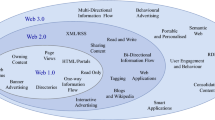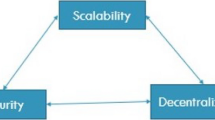Abstract
In the 5G scenario of the convergence of information technology (IT) and communication technology (CT), multi-operators collaborate to form edge computing, which makes the problem of resource optimization more complicated than ever. Users may access resources deployed by various MEC’s operators to achieve ultra-low latency. However, traditional resource management methods consider only a single operator failure to handle profit allocation and privacy security issues among different operators. To address this problem, we proposed a resource management framework named GBRM based on graph embedding and blockchain. Specifically, we use the Stackelberg game model to solve MEC servers’ cache-offloading problem; non-indexed content sharing by Deepwalk graph embedding between MECs ensures the privacy of different operators’ content. Consortium blockchain assists in the trusted profit allocation of services across various operators. Experiments show in the virtual network scenario that our work performance is significantly better than the RandomSelect and the LocalIndex method in global latency and close to the global index’s ideal situation. Multi-operators collaborate to form edge computing, which makes the problem of resource optimization more complicated than ever.





Similar content being viewed by others
References
Abbas N, Zhang Y, Taherkordi A, Skeie T (2018) Mobile edge computing: a survey. IEEE Internet Things J 5(1):450–465
Li J, Chen H, Chen Y, Lin Z, Vucetic B, Hanzo L (2016) Pricing and resource allocation via game theory for a small-cell video caching system. IEEE J Sel Areas Commun 34(8):2115–2129
Lei K, Xie Y, Shi J, Zhang H, Zhang G, Bai B (2018) Optcaching: a Stackelberg game and belief propagation based caching scheme for joint utility optimization in fog computing. In: 2018 IEEE 24th International Conference on Parallel and Distributed Systems (ICPADS), pp 747–754
Zheng Z, Song L, Han Z, Li GY, Poor HV (2018) A Stackelberg game approach to proactive caching in large-scale mobile edge networks. IEEE Trans Wirel Commun 17(8):5198–5211
Xiong Z, Feng S, Niyato D, Wang P, Leshem A, Zhang Y (2018) Game theoretic analysis for joint sponsored and edge caching content service market. In: 2018 IEEE Global Communications Conference (GLOBECOM), pp 1–7
Sarwar B, Karypis G, Konstan J, Riedl J (2001) Item-based collaborative filtering recommendation algorithms. In: Proceedings of the 10th International Conference on World Wide Web, pp 285–295
Perozzi B, Al-Rfou R, Skiena S (2014) Deepwalk: online learning of social representations. In: Proceedings of the 20th ACM SIGKDD International Conference on Knowledge Discovery and Data Mining, pp 701–710
Mikolov T, Chen K, Corrado G, Dean J (2013) Efficient estimation of word representations in vector space. arXiv preprint arXiv:1301.3781
Tang J, Qu M, Wang M, Zhang M, Yan J, Mei Q (2015) Line: Large-scale information network embedding. In: Proceedings of the 24th International Conference on World Wide Web, pp 1067–1077
Dong Y, Chawla NV, Swami A (2017) Metapath2vec: scalable representation learning for heterogeneous networks. In: Proceedings of the 23rd ACM SIGKDD International Conference on Knowledge Discovery and Data Mining, pp 135–144
He Y, Song Y, Li J, Ji C, Peng J, Peng H (2019) Hetespaceywalk: a heterogeneous spacey random walk for heterogeneous information network embedding. In: Proceedings of the 28th ACM International Conference on Information and Knowledge Management, pp 639–648
Gao M, Chen L, He X, Zhou A (2018) Bine: bipartite network embedding. In: The 41st International ACM SIGIR Conference on Research & Development in Information Retrieval, pp 715–724
Huang W, Li Y, Fang Y, Fan J, Yang H (2020) Biane: bipartite attributed network embedding. In: Proceedings of the 43rd International ACM SIGIR Conference on Research and Development in Information Retrieval, Ser. SIGIR ’20. Association for Computing Machinery, New York, pp 149–158 [Online]. https://doi.org/10.1145/3397271.3401068
Nakamoto S (2018) Bitcoin: a peer-to-peer electronic cash system [online]. https://bitcoin.org/bitcoin.pdf
King S, Nadal S (2012) PPCoin: peer-to-peer crypto-currency with proof-of-stake
Vasin P (2014) Blackcoin’s proof-of-stake protocol v2 [online]. https://www.blackcoin.co/blackcoin-posprotocolv2-whitepaper.pdf
Kamara S (2013) Proofs of storage: theory, constructions and applications. In: Muntean T, Poulakis D, Rolland R (eds) Algebraic Informatics. Springer, Berlin, Heidelberg, pp 7–8
Ateniese G, Kamara S, Katz J (2009) Proofs of storage from homomorphic identification protocols. In: Matsui M (ed) Advances in Cryptology—ASIACRYPT 2009. Springer, Berlin, Heidelberg, pp 319–333
Rivest R, Dusse S (1992) The MD5 message-digest algorithm, internet request for comments. Internet Request for Comments (RFC) 1321
Newman ME (2005) Power laws, pareto distributions and zipf’s law. Contemp Phys 46(5):323–351
Elrom E (2019) EOS.IO wallets and smart contracts. Apress, Berkeley, pp 213–256 [Online]. https://doi.org/10.1007/978-1-4842-4847-8_6
Acknowledgements
This work is supported by the National Science Foundation of China (NSFC 62072012), Key-Area Research and Development Program of Guangdong Province (2020B0101090003), Shenzhen Project (JSGG20191129110603831), and Shenzhen Key Laboratory Project (ZDSYS201802051831427).
Author information
Authors and Affiliations
Corresponding author
Additional information
Publisher's Note
Springer Nature remains neutral with regard to jurisdictional claims in published maps and institutional affiliations.
Rights and permissions
About this article
Cite this article
Lei, K., Ye, H., Fang, J. et al. GBRM: a graph embedding and blockchain-based resource management framework for 5G MEC. J Supercomput 78, 16266–16285 (2022). https://doi.org/10.1007/s11227-022-04528-x
Accepted:
Published:
Issue Date:
DOI: https://doi.org/10.1007/s11227-022-04528-x




